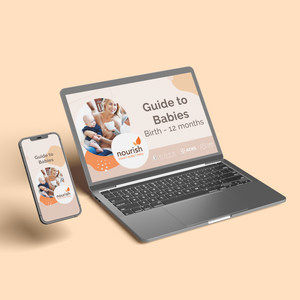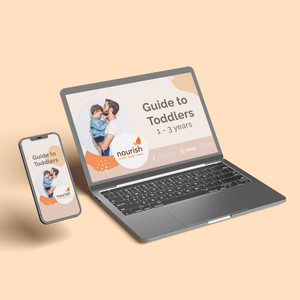Key Points
- Nipples and areolas come in various sizes, shapes, and colors, with each serving the essential function of nourishing and feeding a baby
- Flat and inverted nipples can present challenges when breastfeeding, making it trickier for babies to latch on properly
- Shaping the nipple between thumb and forefinger and using techniques like leveraging the baby's mouth can aid in achieving a better latch - nipple shields can also be considered if the issue persists
- While truly inverted nipples are rare, techniques like shaping, nipple shields, or even pumping before breastfeeding can help ease the attachment process
In pregnancy, lots of mums worry about the size, shape and colour of their nipples and areola. It’s probably the first time we’ve ever thought of these sticking-out bits as having an actual function. And just like women’s body shapes, everyone’s different.
Nipples can be long, short, flat, inverted, or even bell-shaped and still nourish and feed a baby. Areolas can be black, brown, pink, as small as a 10-cent piece, large and saucer-like or something in between – there isn’t a better size or colour and the rumour that blondes and redheads with pale nipples will have more nipple damage than mums with dark areolas is a complete furphy!
Mostly the function of the areola is to keep the nipples soft and moisturised, as the little bumps on them (the Montgomery tubercles) secrete a lubricating, anti-bacterial substance with a self-cleaning mechanism – how cool is that?
While it’s true that babies will get used to the feel of their own mother’s nipples, there are some nipple shapes that can be more difficult than others when learning to attach bubs to the breast.
Inverted and flat nipples are the two most talked-about shape challenges, so here are a couple of tricks I’ve learnt to achieve the best possible latch.
Flat Nipples
If your nipples are quite flat and bubs is sliding around trying to attach to them and getting frustrated, it can help to shape your nipple between your thumb and forefinger and lever the baby’s mouth from underneath the nipple over the top.
Pretend the nipple is a hamburger or sandwich that needs to be squashed together to fit into the baby’s mouth and make sure bub’s chin and bottom lip touches the underside of the breast first. If this still doesn’t work, you could talk to your midwife or lactation consultant about trying a nipple shield, which is a Mexican-hat shaped shield made from thin silicone that suctions onto the nipple and helps bubs stay attached. They can be weaned from the shield later when you both get the hang of it.
Inverted Nipples
Truly inverted nipples are quite rare, I reckon I’ve only seen one or two cases of them in the seven years I’ve been helping mums to breastfeed. When you squeeze an inverted nipple, it actually inverts further into the breast. There are lots of nipples, which appear to point inwards, but when baby sucks, or they are attached to a pump, they start to come out. Some of these even start to evert during pregnancy.
To help a mum to attach a baby to an inverted nipple, again, the same shaping as for flat nipples should work, and a nipple shield can be helpful if latching isn’t successful on the bare breast. Some mums buy nipple everters, which are like suction caps to squeeze onto the breast before a feed. I haven’t seen these used much in Australia, and I think using the shaping or a nipple shield would be just as effective.
Some mums find a few minutes of pumping with a breast pump prior to attaching bubs helps the nipple to come out, or even just softening the aerola with some hand expressing prior to a feed could make the shaping more effective on full breasts.
About the Author: Jane Barry - Your Health Content Expert
Jane Barry is a registered nurse, midwife, and child health nurse with a passion for combining clinical expertise and writing. She has nearly 30 years of specialist experience in child health nursing and holds a Bachelor's Degree in Applied Science (Nursing). Jane specialises in women’s health, parenting, pregnancy, babies and maternity care, child health, nutrition, feeding, teething, and dental health issues.
An active member of AHPRA, The Australasian Medical Writer’s Association, Health Writer Hub, and the Australian College of Children and Young People’s Nurses, Jane Barry delivers health content with professionalism and clarity.
Our Products
-

01. Guide to a Healthy Pregnancy
$55 -

02. Positive Birthing Course
$55 -

03. Infant Feeding Guide
$55 -

04. Baby Sleep Guide - First 12 Months
$55 -

05. Toddler Parenting Course 1 - 3 Years
$55
-
 When to Start Antenatal Classes?
When to Start Antenatal Classes?
Becoming a parent is an incredible milestone, but it comes with a host of changes that can be daunting, especially for first time parents. Antenatal classes are all about offering expectant parents the education they need to make informed decisions, look after their bodies and care for their newborn babies. While you probably already have a long list of things you need to accomplish during your pregnancy, it’s a good idea to make time to attend antenatal classes.
-
 Development Milestones 4-8 Months
Development Milestones 4-8 Months
As they reach the middle of their first year, you'll start to see bigger leaps in their growth and ability!
In this article, we’re going to discuss your baby’s developmental milestones between 4-8 months, and what you can expect along the way.





 When to Start Antenatal Classes?
When to Start Antenatal Classes?
 Development Milestones 4-8 Months
Development Milestones 4-8 Months








